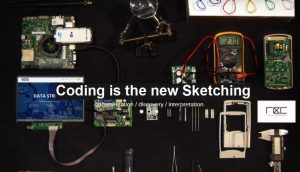Coding is the New Sketching
July 22, 2016It wasn’t that long ago I found myself developing Android Apps for a startup company I created called Architect Machines. The idea was simple. I needed tools to help me do my job that didn’t exist on the market place. These machines (software apps) would help keep me organized and efficient. I had a lot of licenses, certification numbers and renewal dates to remember so I wrote a free app called Member ID to help remind me of that information. Between it and PhotoDoc I had around 10,000 downloads (1,550 active users). By comparison to other apps out there, it failed. My intent wasn’t to make a buck but to create something I could use and others as well. Little did I know that would set me on a journey to explore computer programming for architecture further. While I am not a true programmer, I’m a licensed architect with a background in engineering. My ability to put together a building far outweighs my knowledge of computer programming, but I did learn how to code. This led to tinkering with Arduino sketches (ironically how I thought of the title quote) and that led to Raspberry Pi development and as many of you know, Data Streams w/ co-Founder Michael Vander Ploeg.

Then I saw this fantastic little tool for Revit Architecture called Dynamo at Autodesk University 2013. You can take pre-scripted code and insert them over an open dashboard to manipulate data in Revit similar to Grasshopper for Rhino. Like most code, it’s rule based and its great at math. Two things I find myself doing a lot of in the field of architecture, engineering and building science. In reality, a lot of what we all do, especially repetitive tasks, is math based. What we think is human thought for some types of design criteria is a series of calculations that address possible outcomes. Take for instance a parking garage. There’s probably an assortment of ways to “make” them work, but really it gets narrowed down to 2 or 3 foundations pretty quick. At the end of the day you’re really just looking for a parking stall count and how big that is on the site, then maybe any height restrictions thrown in. The link below is one simplified scenario that allows designers to specify those parameters quickly in order to get faster answers to the team and ultimately to the client. (two story only) https://www.dynamoreach.com/share/5793c57a1cea5a924f4682fb Why would we spend 20+ hours modeling multiple variations of them in Revit or Sketchup when we have a tool like this?
Taking this one step further, we ask ourselves what drives the size of the parking lot? Is it stadium attendees? Then with a little further coding we can have that stadium population data drive the parking data. No need for a person to even open the parking garage model until the stadium options are ready for computation. This idea is a slide-in to generative design.

“Coding is the new sketching”. We start to see a process of extreme speed and accuracy by cleverly coding our design outcomes to meet expectations. While I’m not discouraging napkin sketches, another way of putting it is you state the goals of your problem and have the computer create design iterations for you, as designer you can select the best option. The old way composed of the designer having a dream and drawing it. Coding is one way to extend your idea downstream instead of stopping it on paper.
At RTC North America 2016 I was able to participate as an expert panelist for this discussion involving FormIt360 and Dynamo and the future workflow of design. What I have been witnessing over the past few AU’s and RTC’s is this revolution of parametric driven designing. We can expect our machines to help us with architecture in ways we didn’t think were possible even five years ago. With the technology out there available and forthcoming, the future looks bright!
Please share your thoughts and questions! Is coding the future of design? How does it impact your process and what workflows have you developed to provide better results for you and your clients?
